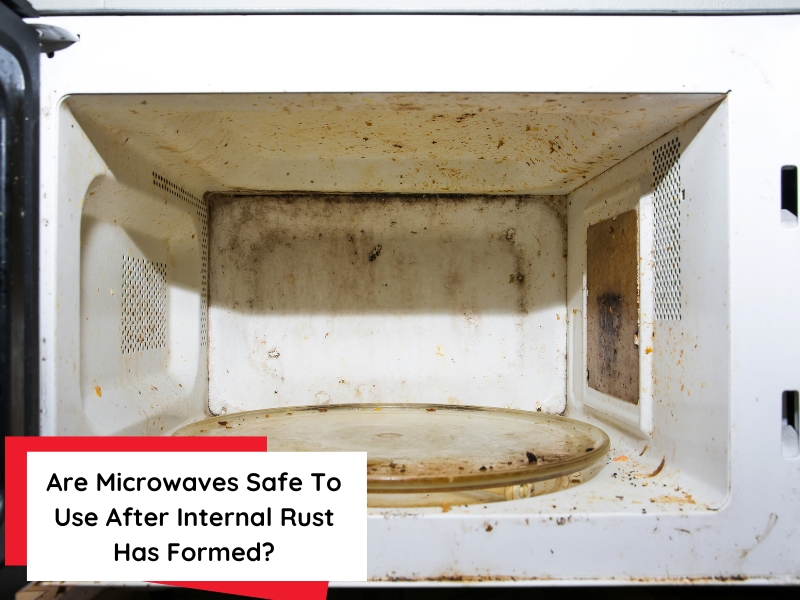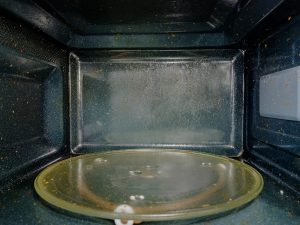What causes rust to form inside a microwave?
Rust inside a microwave typically forms when moisture is trapped in areas where metal components are exposed. Several factors contribute to rust formation, including:
- Moisture build-up: If food spills inside the microwave or if it’s used in a humid environment, moisture can accumulate. This moisture can interact with the metal parts, causing them to rust over time.
- Damage to the interior coating: Microwaves often have a protective layer on the metal surfaces. If this coating gets scratched or chipped, the underlying metal is exposed, which accelerates rusting.
- Food residue: Food particles can get stuck on interior surfaces. If not cleaned properly, these particles can contribute to rust over time.
Is it safe to use a rusty microwave?
If you find rust inside your microwave, it’s essential to determine whether it’s safe to continue using it. Here are some things to consider:
- Minor rust: If the rust is limited to small areas and doesn’t interfere with the microwave’s operation, it may still be safe to use. However, regular maintenance and cleaning will help prevent further damage.
- Major rust: If rust has spread across the interior and is affecting the microwave’s performance, it could lead to malfunctioning parts, making the microwave unsafe to use.
- Electrical concerns: Rust can sometimes affect the microwave’s internal wiring or electronic components, leading to potential electrical hazards.
How can internal rust affect microwave performance?
Rust inside a microwave doesn’t just affect the appliance’s appearance—it can also influence its performance. Here’s how:
- Reduced heating efficiency: Rust can cause irregular heating patterns, which could explain why your microwave is not heating correctly. This means your food might not cook evenly, which is a concern when reheating or defrosting foods.
- Increased cooking time: If the microwave is performing less efficiently, your food may take longer to heat up.
- Noise: Rust can sometimes cause unusual noises when the microwave operates, as it can interfere with the movement of the turntable or other components.
- Shortened lifespan: Over time, rust can damage internal components and reduce the overall lifespan of the microwave.
Can rust in a microwave lead to health issues?
While internal rust is more of a performance issue than a direct health risk, it could still pose concerns. Here’s how:
- Uneven heating: As mentioned earlier, rust can cause uneven heating of food. This could lead to undercooked food, which can result in foodborne illnesses and bacteria that can lead to food poisoning.
- Potential for microwave radiation leaks: In extreme cases, rust can damage the door seal, leading to microwave radiation leaks. While this is rare, exposure to microwave radiation can be harmful.
- Toxic materials from rust: If the rust affects the interior coating or the metal itself, there’s a slight chance that particles could enter the food, posing a health risk if consumed.
How do you identify if your microwave has internal rust?
Rust can sometimes be challenging to detect until it’s too late. Here are some signs to look out for:
- Visible rust spots: If you notice any rust stains or spots inside the microwave, it’s a clear sign that rust is present.
- Discolouration of the interior: Rust can cause the interior of the microwave to change colour, usually to a reddish or brownish hue.
- Unusual noises: If you hear odd sounds, such as a buzzing or grinding noise, it may indicate that rust is affecting the magnetron or other internal parts.
If you notice any of these signs, it’s essential to investigate further and take action to either clean or replace your microwave. Understanding when to replace your microwave is key to maintaining a safe and efficient kitchen.
What should you do if you discover a rusty microwave?
If you find rust inside your microwave, here’s what you should do:
- Clean it thoroughly: Use a mild abrasive like baking soda and a cloth to scrub rusted areas without damaging the interior coating.
- Inspect for damage: Minor rust may not require replacement, but extensive damage might need professional inspection.
- Replace the magnetron: If rust affects the magnetron, it may need replacing, which can be costly.
- Consider replacement: If the rust is severe or the microwave isn’t functioning correctly, replacing it may be the best option.
How can you prevent rust from forming inside your microwave?
Preventing rust from forming inside your microwave is possible with the proper care. Here are a few tips:
- Wipe up spills immediately: If food or liquid spills inside the microwave, wipe it up straight away to prevent moisture build-up.
- Keep the microwave dry: After each use, leave the microwave door open for a few minutes to allow any moisture to evaporate.
- Avoid abrasive cleaners: Harsh cleaning agents can scratch the microwave’s interior, exposing the metal and leading to rust. Stick to mild cleaners.
- Clean the interior regularly: A clean microwave is a happy microwave. Clean the interior regularly to prevent food particles from accumulating.
Should you replace or repair a rusty microwave?
Whether you should repair or replace a rusty microwave depends on the severity of the damage. Here’s how to make the decision:
- Repair: If the rust is minimal and doesn’t affect the microwave’s performance, a simple cleaning or replacement of damaged parts might be enough to restore its functionality.
- Replace: If the rust is widespread, affecting multiple components or making the microwave unsafe to use, it may be better to invest in a new appliance.
Taking care of your microwave
Rust inside a microwave isn’t something to ignore, as it can affect performance and safety. Whether it’s a minor inconvenience or a sign of more serious damage, addressing rust early can save you time and money in the long run.
Looking for an affordable, high-quality microwave replacement? Microwave Factory offers refurbished and factory-second microwaves at discounted prices. All products come with a warranty so that you can buy them with confidence. Upgrade your kitchen without breaking the bank. Contact Microwave Factory today to find the perfect microwave for your needs!



